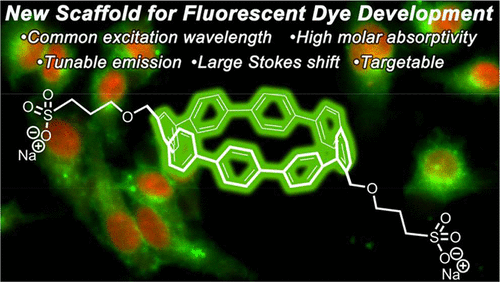当前位置:
X-MOL 学术
›
ACS Cent. Sci.
›
论文详情
Our official English website, www.x-mol.net, welcomes your
feedback! (Note: you will need to create a separate account there.)
Expanding the Chemical Space of Biocompatible Fluorophores: Nanohoops in Cells
ACS Central Science ( IF 12.7 ) Pub Date : 2018-08-30 00:00:00 , DOI: 10.1021/acscentsci.8b00346 Brittany M. White 1 , Yu Zhao 1 , Taryn E. Kawashima 1 , Bruce P. Branchaud 1 , Michael D. Pluth 1 , Ramesh Jasti 1
ACS Central Science ( IF 12.7 ) Pub Date : 2018-08-30 00:00:00 , DOI: 10.1021/acscentsci.8b00346 Brittany M. White 1 , Yu Zhao 1 , Taryn E. Kawashima 1 , Bruce P. Branchaud 1 , Michael D. Pluth 1 , Ramesh Jasti 1
Affiliation

|
The design and optimization of fluorescent molecules has driven the ability to interrogate complex biological events in real time. Notably, most advances in bioimaging fluorophores are based on optimization of core structures that have been known for over a century. Recently, new synthetic methods have resulted in an explosion of nonplanar conjugated macrocyclic molecules with unique optical properties yet to be harnessed in a biological context. Herein we report the synthesis of the first aqueous-soluble carbon nanohoop (i.e., a macrocyclic slice of a carbon nanotube prepared via organic synthesis) and demonstrate its bioimaging capabilities in live cells. Moreover, we illustrate that these scaffolds can be easily modified by well-established “click” chemistry to enable targeted live cell imaging. This work establishes the nanohoops as an exciting new class of macrocyclic fluorophores poised for further development as novel bioimaging tools.
中文翻译:

扩大生物相容性荧光团的化学空间:细胞中的纳米环
荧光分子的设计和优化驱动了实时查询复杂生物事件的能力。值得注意的是,生物成像荧光团的大多数进步都基于对核心结构的优化,而这种结构已经有一个多世纪了。近来,新的合成方法导致了具有独特光学性质的非平面共轭大环分子的爆炸,尚未在生物学背景下加以利用。本文中,我们报道了第一种水溶性碳纳米环(即通过有机合成制备的碳纳米管的大环切片)的合成,并证明了其在活细胞中的生物成像能力。此外,我们说明了这些支架可以通过公认的“点击”化学方法轻松修饰,以实现靶向活细胞成像。
更新日期:2018-08-30
中文翻译:

扩大生物相容性荧光团的化学空间:细胞中的纳米环
荧光分子的设计和优化驱动了实时查询复杂生物事件的能力。值得注意的是,生物成像荧光团的大多数进步都基于对核心结构的优化,而这种结构已经有一个多世纪了。近来,新的合成方法导致了具有独特光学性质的非平面共轭大环分子的爆炸,尚未在生物学背景下加以利用。本文中,我们报道了第一种水溶性碳纳米环(即通过有机合成制备的碳纳米管的大环切片)的合成,并证明了其在活细胞中的生物成像能力。此外,我们说明了这些支架可以通过公认的“点击”化学方法轻松修饰,以实现靶向活细胞成像。











































 京公网安备 11010802027423号
京公网安备 11010802027423号